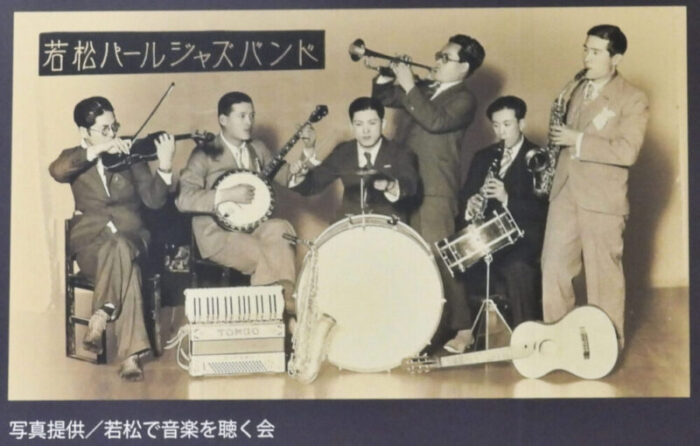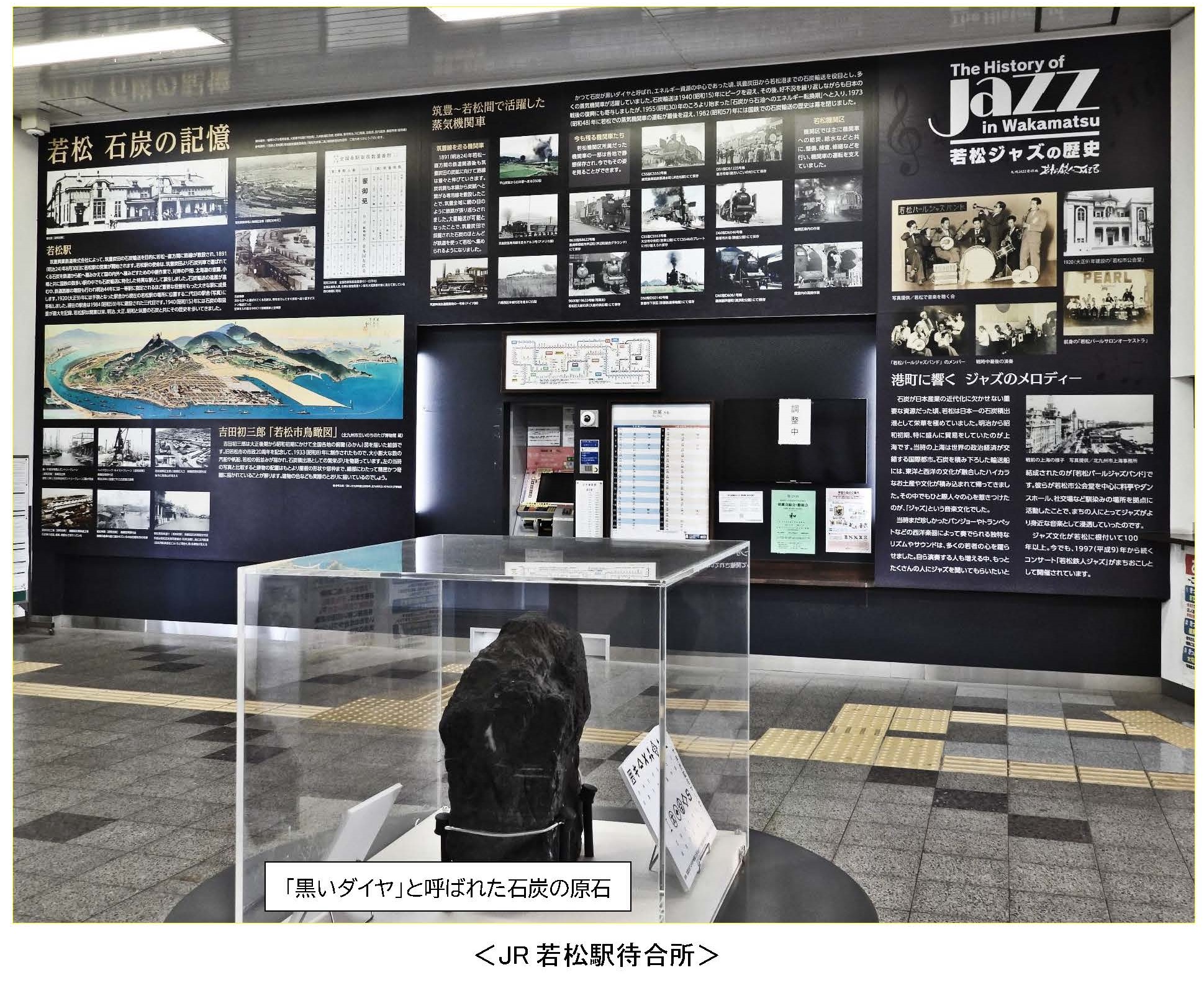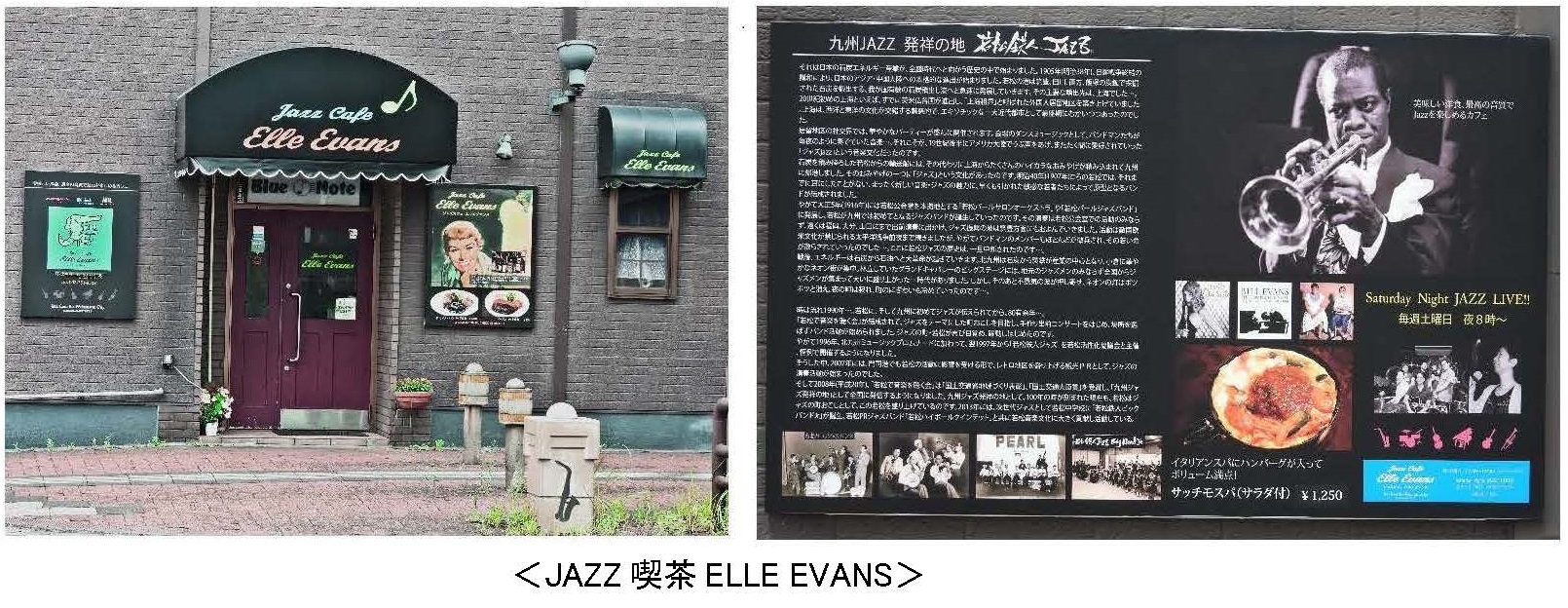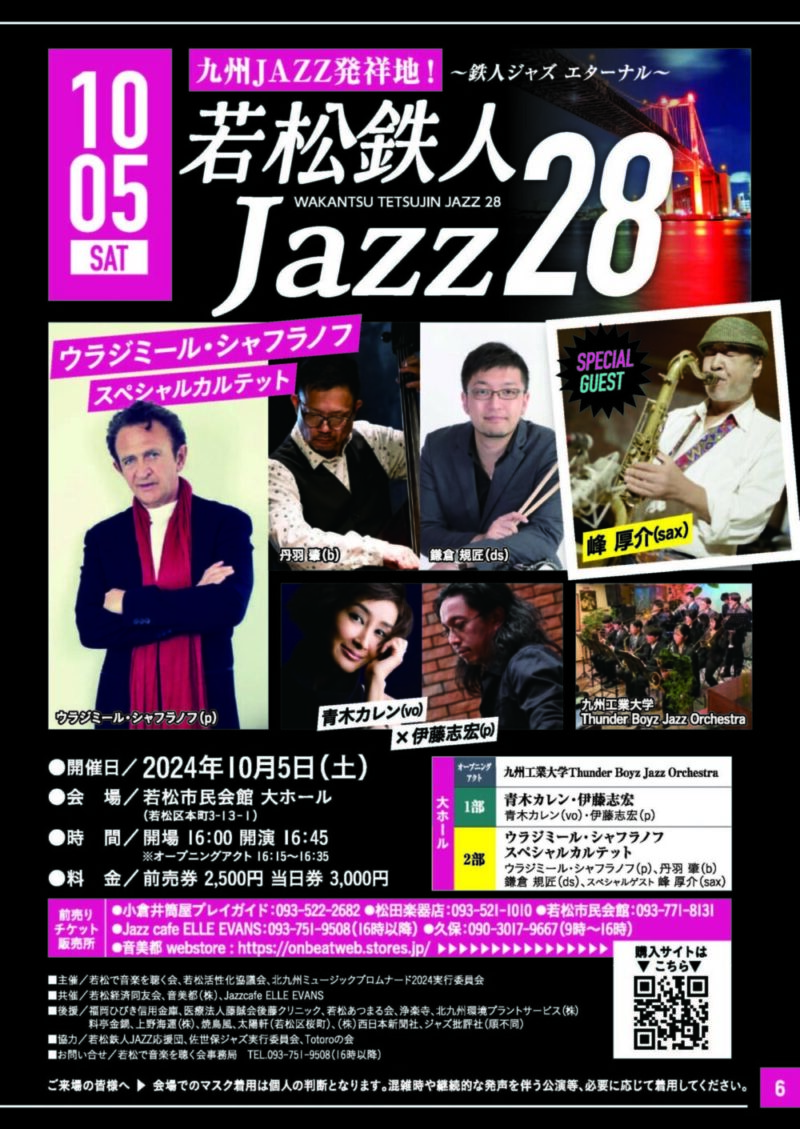Revitalizing “Wakamatsu” through music
(The Wakamatsu Jazz tradition that has been passed down from generation to generation)
Feature PICK UP 若松を興す

The first jazz band to be formed in Kyushu (1916)
Wakamatsu Station, the starting and ending point of the JR Chikuho Line, is no longer the prosperous place it once was. As one exits the unmanned ticket gate, a large panel on the right wall tells the history of jazz in Wakamatsu. During the boom years of the coal economy, the high-colored jazz music popular in Shanghai, China, was also played in this city. The “Wakamatsu culture” was nurtured during the coal boom, which was similar to a gold rush. The young people who were attracted to jazz were also its bearers.
Wakamatsu Culture and Jazz Fostered by Coal
Wakamatsu prospered along with coal. In the early 1910s, more than half of the 20,000 tons of coal extracted in Japan was mined in the Chikuho coalfield, and 80% of this was shipped from the port of Wakamatsu both domestically and abroad. Wakamatsu was indeed one of the largest coal handling cities in Japan at that time.
With a large influx of coal workers not only from Japan but also from neighboring Asian countries, the city’s population swelled to 30,000, and Wakamatsu became the economic center of northern Kyushu and a bustling cultural city. In the central area of the city (today’s Honmachi neighborhood), theaters and movie theaters lined the streets, and in the early Showa period, playhouses (Asahiza and Mainichi Kan) and movie theaters (Shochiku Kan, Kirakukan, Wakamatsu Club, and Shuei), where first-class musicians performed, were very popular.
In addition, the Osaka Sumo Tournament was held in Wakamatsu at Ebisu Shrine, and painters and sculptors gathered in Doi-cho and Hakusan-dori, giving the area the feel of an art village.
Near the ferry terminal, the buildings of Mitsubishi Coal, a wooden Gothic-style coal trading company, a red-brick steamship company, and a waterfront police station lined the street, while the masts of motor sailing ships lined the wharf and the smoke from the seven-wheelers burning coal on board was a scene unique to Wakamatsu Port.
The jazz culture of Wakamatsu, nurtured in this unique scenery, maintained a strong popularity among young people. In the middle of the Meiji period (1868-1912), high-color jazz music brought through the coal route to Shanghai stimulated the sensibility of young people, and in 1916, the first jazz band in Kyushu, the “Wakamatsu Pearl Jazz Band,” was born. Their performance activities spread to Fukuoka, Oita, and Yamaguchi, and it is said that the wave of jazz promotion extended to the coal-producing Chikuho region.

Jazz Culture in Asia Spread from the “Shanghai Concession”
Jazz is a fusion of black and white music that began in New Orleans in the mid-19th century and quickly spread to Chicago, New York, and other major cities. The jazz space created by improvisation and swing was a spiritual home that stimulated the sensibilities of people living in a chaotic era.
Jazz music was introduced to Shanghai in the 1920s and 1930s in the “concession,” an area inhabited by British, American, and French expatriates. At that time, Shanghai was an exotic modern city where Western and Eastern cultures intermingled, and it was also the largest cutting-edge city in China, where the interests of the world powers clashed.
In the midst of this situation, top-class musicians from the U.S. came to Shanghai to take advantage of the booming economy, and musicians from neighboring Asian countries such as Japan and the Philippines also traveled to Shanghai to “learn the techniques and taste of authentic American playing” and established their own jazz bands upon their return.
Interest in Shanghai jazz grew in Korea, then a Japanese colony, and in 1929, the first jazz band in Korea, the Korea Jazz Band, was born. According to a newspaper article, “Each performance was greeted with enthusiastic cheers from young people who were captivated by the innocent tones of the music,” but the article also introduced the reaction of intellectuals who criticized the public at the time for being captivated by the enthusiasm of jazz.
In the midst of the approaching footsteps of military boots, jazz music, which was fostered in the extraterritorial “Shanghai Concession,” was marginalized as enemy music, but it was also the cutting-edge popular music that was close to the free sensibilities of the young people.
However, with the expansion of the Pacific War, British and American music was banned, and a “ban on the performance and appreciation of jazz” was issued, bringing jazz in Asia to a virtual standstill.
Jazz-themed community development from Wakamatsu
After the war, the presence of the General Headquarters of the Allied Forces (GHQ) encouraged the revival of jazz in Japan. As Japan’s economy shifted from reconstruction to boom, even in the provincial city of Kokura, the glamorous neon district was revived and jazz music became increasingly popular. However, with the subsequent recession and the energy shift from coal to oil, the Chikuho coal fields were closed one after another in the 1970s, and the bustle of Wakamatsu rapidly waned, becoming a memory of the past.
More than a decade later, the “Wakamatsu Music Listening Group” was established in 1991 to revive jazz in Wakamatsu and revitalize the town, led by the late Kanji Wada, owner of the jazz cafe ELLE EVANS, The activities of this group, which was led by the late Mr. Kanji Wada, owner of the JAZZ cafe ELLE EVANS, have led the music scene not only in Wakamatsu, but also in Kitakyushu.

n 1993, they formed the “Volunteer Town Revitalization Band,” and in 1995, they held a charity street live concert for the Great Hanshin Earthquake at a local shopping street and Green Park. In 1997, he held “Select in Wakamatsu” at the Wakamatsu Civic Hall, which later evolved into the annual “Wakamatsu Tetsujin Jazz” event.
In 2008, he received the “Minister of Land, Infrastructure, Transport, and Tourism Award for Regional Development” at the National Exchange Conference for Regional Development sponsored by the Ministry of Land, Infrastructure, Transport, and Tourism. The event was also widely covered by the mass media.

Wakamatsu Tetsujin Jazz” will be held again this year in early October.
Even after the passing of Mr. Kan’ichi Wada, who contributed to the revival of jazz culture in Wakamatsu, the “Wakamatsu Tetsujin Jazz,” now in its 28th year since its inception in 1997, is a representative music event of Wakamatsu, the birthplace of jazz in Kyushu, and the signature event of the Kitakyushu Music Promenade. It is also the signature event of the Kitakyushu Music Promenade.
Famous jazz musicians always appear on Tetsujin Jazz, and this year’s lineup includes Vladimir Shafranov, a jazz pianist from Northern Europe who is also popular in Japan, a duo appearing on Tetsujin Jazz for the first time, a bassist currently based in Western Japan, and a veteran tenor saxophonist from the past.
The opening act, the “Thunder Boys Jazz Orchestra of Kyushu Institute of Technology,” will also be interesting. The “Wakamatsu Tetsujin Jazz” concert will be held on Saturday, October 5 at the Wakamatsu Civic Hall, starting at 6:00 p.m.

References:
- Chutokai” by Ashihei Hino, Ashihei Hino’s Selected Works, Vol. 8, Tokyo Sogensha, June 30, 1955.
- Wakamatsu Konjaku Monogatari” by Toshiaki Yoshino, Nishinippon Shimbun, November 1996.
- Jazz Kotohajme by Eichi Tomizawa, https://jp.yamaha.com/sp/myujin/tag/
- “Shanghai Jazz Fever in the 1930s Captivates Chosun’s Youth,” The Dong-A Ilbo, May 2019.








